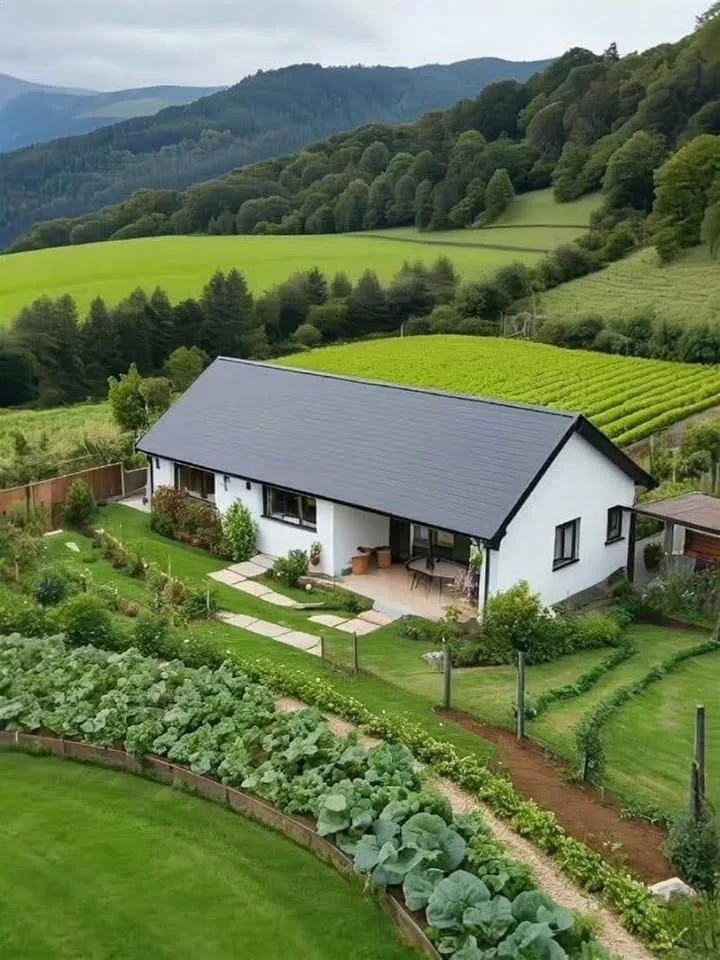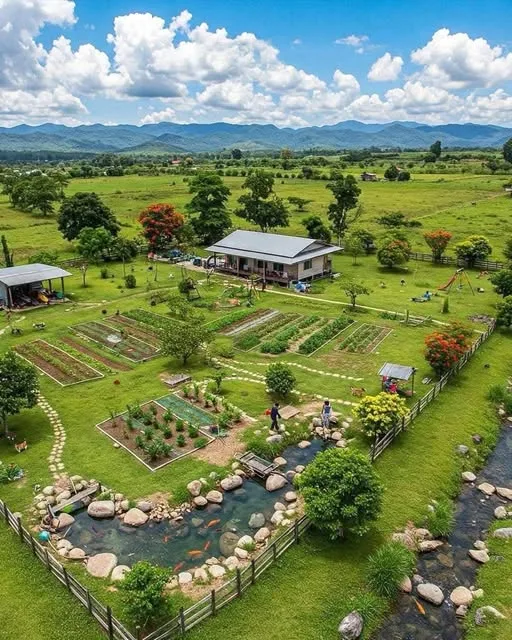In a world that often equates success with flashy possessions—designer handbags, luxury cars, and endless notifications—the quiet allure of open spaces calls to a different kind of soul. “The goal is neverrr Gucci bags,” reads a viral meme overlaid on an aerial photo of a modest homestead nestled in misty fields. “The goal is acres of land.” This simple image, with its vegetable gardens, a small pond teeming with fish, a hammock swaying between trees, and a cozy house under a vast sky, captures the essence of a peaceful life. It’s a life unhurried, self-sufficient, and profoundly solitary. For the solo traveler, this isn’t just a destination; it’s a philosophy. This article explores how embracing solitude on the road leads to inner peace, self-discovery, and a redefined sense of home—far from the clamor of consumer culture.
The Allure of Solitude in a Connected World

Solo travel has surged in popularity over the past decade, with surveys from organizations like Booking.com reporting that over 50% of travelers now prefer going alone at least occasionally. Why? In an era of constant connectivity—social media feeds, work emails, and group chats—solitude offers a rare commodity: uninterrupted thought. The peaceful life isn’t about isolation for its own sake; it’s about reclaiming agency over one’s time and mind.
Imagine waking up in a remote cabin in the Scottish Highlands, the only sound the whisper of wind through heather. No itinerary dictated by companions, no compromises on dinner choices. As a solo traveler, you set the pace. Henry David Thoreau, in his seminal work Walden, extolled the virtues of simple living by a pond, much like the one in our meme’s homestead. He wrote, “I went to the woods because I wished to live deliberately.” Modern solo travelers echo this sentiment, trading urban hustle for rural expanses where acres of land symbolize freedom, not just property.
This peace manifests physically and mentally. Studies from the Journal of Personality and Social Psychology show that intentional solitude reduces stress hormones like cortisol, fostering creativity and emotional resilience. For the solo wanderer, a plot of land—whether owned, rented, or simply traversed—becomes a canvas for this deliberate living.
The Journey Begins: Packing Light, Living Large

The solo traveler’s toolkit is minimalist, mirroring the homestead’s unpretentious vibe. Forget the Gucci bag; pack a sturdy backpack with essentials: a journal, a multi-tool, seeds for impromptu gardening, and a good pair of boots. The goal is mobility and self-reliance.
Start small. Many begin with weekend escapes to national parks. In the United States, places like Great Smoky Mountains or Yellowstone offer vast acres where one can hike alone, camp under stars, and forage for wild edibles. European counterparts include the Camino de Santiago in Spain—a 500-mile pilgrimage walked solo by thousands annually—or the rugged trails of Norway’s fjords.

As you venture farther, the peaceful life unfolds in layers. In New Zealand’s South Island, solo travelers rent tiny homes on sheep farms, tending gardens by day and stargazing by night. One such traveler, documented in travel blogs like Nomadic Matt, described planting potatoes on a borrowed acre: “It wasn’t about the harvest; it was the act of putting roots down, even temporarily, in silence.”
Financially, this lifestyle is accessible. Van life, popularized on platforms like Instagram, allows nomads to convert vehicles into mobile homesteads for under $20,000. Park on public lands (with permits), grow micro-greens in window boxes, and fish in nearby streams. The meme’s pond with koi fish? Replicate it with a portable aquaponics setup, blending travel with sustainable living.

Cultivating Peace: Lessons from the Land
At the heart of the peaceful solo life is a return to the earth. The homestead in the image isn’t lavish—raised garden beds, a chicken coop, fruit trees—but it’s abundant. Solo travelers learn this through homesteading retreats or Workaway programs, where you exchange labor for lodging on organic farms worldwide.
In Thailand’s Chiang Mai region, volunteers live in bamboo huts, harvesting rice and meditating at dawn. The solitude here is profound; no small talk distracts from the rhythm of planting and weeding. Research from the University of Derby’s nature connection studies links such activities to “green exercise,” boosting mood and purpose.
Spiritually, solitude amplifies introspection. Buddhist traditions emphasize vipassana retreats in silence, lasting 10 days or more. Solo travelers in India’s Himalayas or Myanmar’s monasteries report epiphanies: “Gucci bags gather dust; land nourishes the soul.” This isn’t hyperbole—neurocience backs it. MRI scans show solitary reflection activates the default mode network, enhancing self-awareness and empathy.

Yet, peace isn’t passive. Challenges arise: loneliness creeps in during rain-soaked nights, or wildlife startles the unprepared. Seasoned soloists counter with routines—morning yoga in the fields, evening fireside reading. Books like Cheryl Strayed’s Wild chronicle such trials on the Pacific Crest Trail, transforming fear into fortitude.
Building a Nomadic Homestead: Acres on the Move
Ownership isn’t prerequisite for the “acres of land” dream. Digital nomads blend travel with semi-permanent bases. Buy a plot in affordable regions like Portugal’s Alentejo or rural Mexico, then travel seasonally. Tiny house communities in Oregon or eco-villages in Costa Rica welcome part-timers.
Technology aids without intruding. Solar panels power off-grid setups; apps like iNaturalist identify plants for foraging. The meme’s hammock? String one between trees in any campsite for instant serenity.

Communities form organically. Solo traveler forums on Reddit (r/solotravel) share stories of serendipitous connections—trading seeds with a fellow wanderer in Patagonia or joining a harvest festival in Tuscany. These bonds are fleeting, preserving solitude’s core.
Environmentally, this lifestyle treads lightly. Regenerative farming on personal acres restores soil; travel by train or bike minimizes carbon footprints. Organizations like WWOOF (World Wide Opportunities on Organic Farms) connect soloists to sustainable plots globally.
The Inner Landscape: Self-Discovery Amid Solitude
Peaceful living rewires priorities. Materialism fades when sunrise over your garden outshines any boutique window. Solo travel fosters resilience; navigating foreign lands alone builds confidence. A 2022 study in Tourism Management found solo female travelers, in particular, report heightened empowerment.
Health benefits abound. Fresh air, homegrown food, and physical labor combat sedentary ills. Mental clarity sharpens—journaling under oak trees like those in the image yields insights no therapy session matches.
Romantic notions aside, realism tempers the idyll. Winters on remote land demand preparation; visas limit stays. Yet, these hurdles hone adaptability, the solo traveler’s superpower.

Sustaining the Dream: Long-Term Strategies
For longevity, diversify. Monetize skills remotely—freelance writing about your journeys, or sell homestead produce at markets. Investments in land trusts ensure affordability.

Retirement? Many envision permanent homesteads, inspired by the meme. In the U.S., programs like the Homestead Act’s modern echoes offer cheap rural plots. Abroad, countries like Ecuador entice with low-cost visas for self-sufficient expats.
Ultimately, the peaceful life is cyclical. Travel feeds the soul; land grounds it. One solo traveler in a viral X post (formerly Twitter) summed it: “I left the city with a backpack. Returned with stories, scars, and a deed to five acres. Gucci? Never owned one.”

Conclusion: Acres of the Heart
The meme’s message resonates because it subverts societal scripts. Gucci bags symbolize fleeting status; acres of land embody enduring peace. For the solo traveler, this isn’t escapism—it’s evolution. In solitude, we confront ourselves, cultivate abundance, and find home not in things, but in the vast, quiet spaces within and without.
Whether you’re pitching a tent in the Rockies, tending a balcony garden in a high-rise, or claiming your first plot of earth, start small. The journey to a peaceful life begins with one step alone. As the mist clears over that humble homestead, so does the path to true fulfillment. The goal was never the bag. It was always the land—and the freedom to roam it solo.






